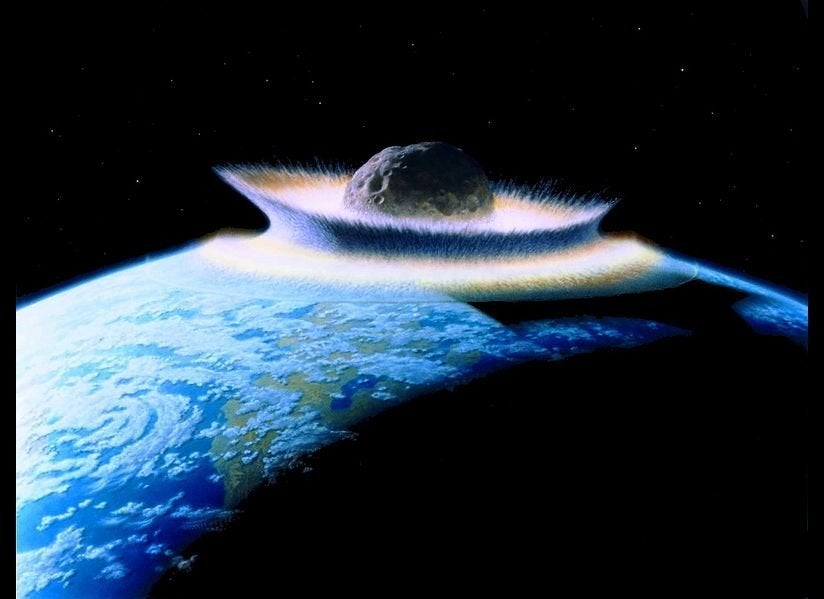The recent meteor strike over Chelyabinsk, Russia is reminding all of us just how vulnerable we are to attacks from above. So I reached out to Phil Plait, who writes the Bad Astronomy column at Slate magazine. Because who better to talk to about asteroids than the author of a book called "Death From The Skies!"?
To learn more, see the video above or click the link below to read the full transcript. And don't forget to comment at the bottom of the page. Come on, talk nerdy to me!
PHIL PLAIT: Historically we find meteorites all over the world. I have one that was from South America. This fell about 4,000 years ago. And it's iron, it's very heavy, it's the size of my fist, it weighs over a pound. You don't want this thing dropping on your foot if you just let go of it. You certainly don't want it hitting your house when it's moving at 50 times faster than a rifle bullet. That's why astronomers take this threat seriously. It's something that we need to be concerned about.
CARA SANTA MARIA: Hi everyone, Cara Santa Maria here. The recent meteor strike over Chelyabinsk, Russia is reminding all of us just how vulnerable we are to attacks from above. So I reached out to Phil Plait, who writes the Bad Astronomy column at Slate magazine. Because who better to talk to about asteroids than the author of a book called "Death From The Skies!" So Phil, inquiring minds want to know, how common are these cosmic projectiles?
PP: The Earth gets hit by about a hundred tons of material every single day, and they're usually about the size of a grain of sand. The bigger something is, the more rare it is. So the Chelyabinsk meteor, this thing that came in over Russia, that was big. That was about 50 feet across. Those are very rare. We estimate they only come in once a century.
CSM: A hundred tons of material a day? Large impacts once a century? You'd think we'd see evidence of that all over our planet. It is 4.5 billion years old, after all. And in fact, Earth is covered in craters, but we can't see many of them anymore, because they've been eroded away by wind and water.
PP: The most famous one is probably in Arizona. (Meteor Crater: it's about a mile across.) The most famous impact would have been the one that wiped out the dinosaurs 65 million years ago. That was an object 10 kilometers (six miles) across. But you don't have to go back that far. In 1908, on June 30, something 50, 30 yards across--that size, the size of a big house or somebody's yard--came screaming in over Siberia and exploded. It was a very large impact. Something like that happening today would be very bad.
CSM: And if something like that were to happen today, would we be prepared?
PP: If we were to spot an asteroid headed towards Earth tonight that is going to hit us in a year, there's not a lot we can do about it.
CSM: Well that doesn't sound very promising.
PP: But we have a lot of ideas right now, and some of them involve whacking it with a rocket and trying to push it into a safer orbit, or possibly throwing a bomb at it to do the same thing. Putting a space probe near it so that you can use the gravity of the probe to pull on the asteroid and given enough time, as wacky as that sounds, that will actually work. You can use laser beams to heat the thing up. If it's spinning, that can actually help with this bizarre effect where it gives off heat in one direction, to actually act like a little bit of a rocket and push the asteroid into a safe orbit. There are all these plans, and they're all really cool, and we think a lot of them will work, but none of them is here.
CSM: Hmm...well...don't worry too much. We can track large objects years in advance, and we don't have any imminent threats right now. In fact, you can download a widget from NASA's Jet Propulsion Laboratory website that shows all of our upcoming close encounters. But it's the small impacts that we can't track, like the Chelyabinsk meteor. We have no way to see them coming--our instruments just aren't sensitive enough yet.
PP: It came in the day before--just 16 hours before--we were passed by a much larger asteroid (about 50 meters across). And they are totally unrelated. This was a complete coincidence. The asteroid that passed us, 2012 DA14, was on a completely different orbit than this thing that came in over Russia. That right there basically closes the book on any chance they were related.
CSM: Wait wait wait. Asteroid, meteor. I'm confused. What's the difference?
PP: What we call something pretty much depends on where it is. So while something is orbiting the sun it's called an asteroid. As it's entering the Earth's atmosphere, the bit of it that's actually solid--whatever it is, the rock, the metal--we call it a meteoroid. As it's burning up in the Earth's atmosphere and is very bright, we call it a meteor. And if it hits the ground, we call it a meteorite. So an asteroid and a meteoroid and a meteor and a meteorite--yeah that's everything--it just depends on what it's doing and where it is.
CSM: And there are literally billions of asteroids whizzing by us all the time, and eventually, some of them will come crashing to Earth. So let me know what you think. Are you concerned about a threat from the skies? Come on, talk nerdy to me!
See all Talk Nerdy to Me posts.
Like Cara Santa Maria on Facebook.
Follow Cara Santa Maria on Twitter.
